WISKUNDE
GRAAD 10
NOG OEFENINGE
Waarskynlikheid.
GRAAD 10
NOG OEFENINGE
Waarskynlikheid.
MATHEMATICS
GRADE 10
MORE EXERCISES
Probability.
GRADE 10
MORE EXERCISES
Probability.
1. Gegee die volgende Venn diagram. Gebruik die
diagram om die volgende te bereken :
1.1 P(A)
1.2 P(nie B nie)
1.3 P(A en B)
1.4 P(nie B nie en A)
1.5 P(A of B)
1.6 P(net/slegs A)
1. Given the following Venn diagram. Use the diagram
to calculate the following :
1.1 P(A)
1.2 P(not B)
1.3 P(A and B)
1.5 P(A or B)
diagram om die volgende te bereken :
1.1 P(A)
1.2 P(nie B nie)
1.3 P(A en B)
1.4 P(nie B nie en A)
1.5 P(A of B)
1.6 P(net/slegs A)
1. Given the following Venn diagram. Use the diagram
to calculate the following :
1.1 P(A)
1.2 P(not B)
1.3 P(A and B)
1.5 P(A or B)
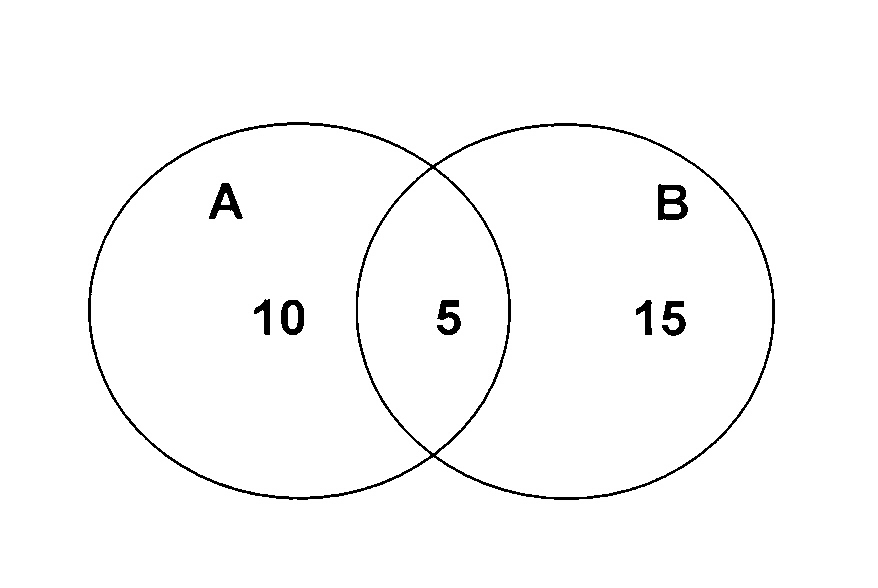
1.4 P(not B and A)
1.6 P(only A)
2. Daar is 50 Graad 10 dogters in 'n sekere skool.
30 dogters speel Netbal (N) en 18 dogters speel
hokkie (H) terwyl 8 dogters netbal en hokkie speel.
2.1 Stel die inligting deur 'n Venn diagram voor.
2.2 Gebruik die Venn diagram om die waarskynlikheid,
in sy eenvoudigste vorm, te bereken dat 'n
willekeurig gekose dogter
2.2.1 netbal speel.
2.2.2 nie hokkie speel nie.
2.2.3 netbal en hokkie speel.
2.2.4 nie netbal of hokkie speel nie.
2.2.5 net netbal speel.
2.3 Is N en H ondrling uitsluitend? Gee 'n rede.
30 dogters speel Netbal (N) en 18 dogters speel
hokkie (H) terwyl 8 dogters netbal en hokkie speel.
2.1 Stel die inligting deur 'n Venn diagram voor.
2.2 Gebruik die Venn diagram om die waarskynlikheid,
in sy eenvoudigste vorm, te bereken dat 'n
willekeurig gekose dogter
2.2.1 netbal speel.
2.2.2 nie hokkie speel nie.
2.2.3 netbal en hokkie speel.
2.2.4 nie netbal of hokkie speel nie.
2.2.5 net netbal speel.
2.3 Is N en H ondrling uitsluitend? Gee 'n rede.
2. In a certain there are 50 Grade 10 girls.
30 girls play Netball (N) and 18 girls play Hockey (H).
8 girls play Netball and Hockey.
2.1 Represent this information on a Venn diagram.
2.2 Use the Venn diagram to calculate in its simplest
form the probability that a girl chosen at random will
2.2.1 play netball.
2.2.2 not play hockey.
2.2.3 play netball and hockey.
2.2.4 not play netball or hochey.
2.2.5 only play netball.
2.3 Is N and H mutually exclusive? Given a reason.
30 girls play Netball (N) and 18 girls play Hockey (H).
8 girls play Netball and Hockey.
2.1 Represent this information on a Venn diagram.
2.2 Use the Venn diagram to calculate in its simplest
form the probability that a girl chosen at random will
2.2.1 play netball.
2.2.2 not play hockey.
2.2.3 play netball and hockey.
2.2.4 not play netball or hochey.
2.2.5 only play netball.
2.3 Is N and H mutually exclusive? Given a reason.
3. Die volgende Venn diagram stel die leerlinge
wat Wiskunde (X) en Fisiese Wetenskap (Y)
neem, voor. Bereken die waarskynlikheid, in sy
eenvoudigste vorm, dat 'n willekeurig gekose leerling
3.1 Wiskunde neem.
3.2 net Fisiese Wetenskap neem.
3.3 beide Wiskunde en Fisiese Wetenskap neem.
3.4 nie een van die twee neem nie.
3.5 Wiskunde of Fisiese Wetenskap neem.
3.6 net Wiskunde of net Fisiese Wetenskap neem.
3. The following Venn diagram represents the pupils
wat Wiskunde (X) en Fisiese Wetenskap (Y)
neem, voor. Bereken die waarskynlikheid, in sy
eenvoudigste vorm, dat 'n willekeurig gekose leerling
3.1 Wiskunde neem.
3.2 net Fisiese Wetenskap neem.
3.3 beide Wiskunde en Fisiese Wetenskap neem.
3.4 nie een van die twee neem nie.
3.5 Wiskunde of Fisiese Wetenskap neem.
3.6 net Wiskunde of net Fisiese Wetenskap neem.
3. The following Venn diagram represents the pupils
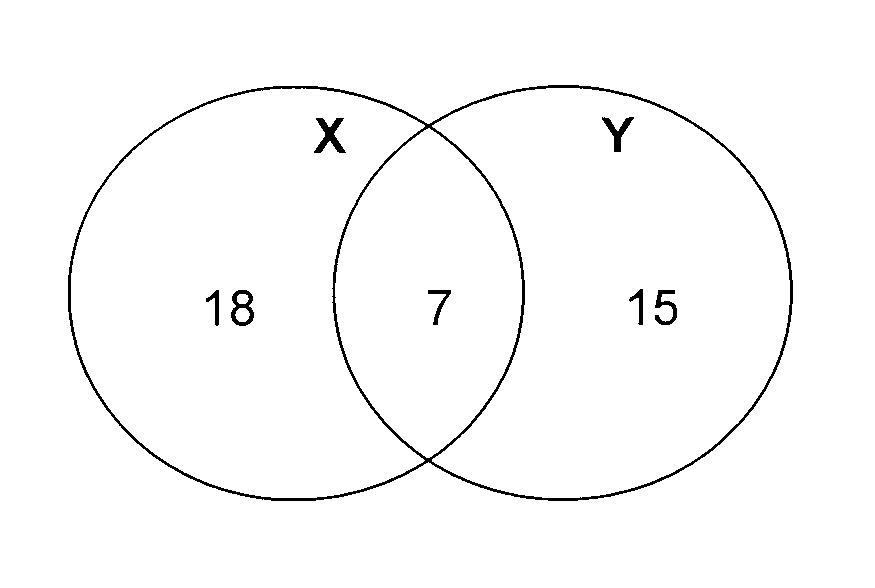
that take Mathematics (X) and Physical Science(Y). Calculate the probability, in its simplest form, that
a pupil, selected at random, takes
a pupil, selected at random, takes
3.1 Mathematics.
3.3 both Mathematics and Physical Science.
3.5 Mathematics or Physical Science.
3.2 only Physical Science.
3.4 neither Mathematics nor Physical Science.
3.6 only Mathematics or only Physical Science.
4. Beskou die volgende Venn diagram.
Gebruik die diagram om die volgende te bepaal :
4.1 n(A)
4.2 n(B of C)
4.3 n(nie (B en C)nie)
4.4 n(nie A nie)
4.5 P(A)
4.6 P(nie (A of B) nie)
4.7 P(A en B en C)
4. Study the following Venn diagram.
Use the diagram to determine
4.1 n(A)
4.2 n(B or C)
4.3 n(not (B and C))
Gebruik die diagram om die volgende te bepaal :
4.1 n(A)
4.2 n(B of C)
4.3 n(nie (B en C)nie)
4.4 n(nie A nie)
4.5 P(A)
4.6 P(nie (A of B) nie)
4.7 P(A en B en C)
4. Study the following Venn diagram.
Use the diagram to determine
4.1 n(A)
4.2 n(B or C)
4.3 n(not (B and C))
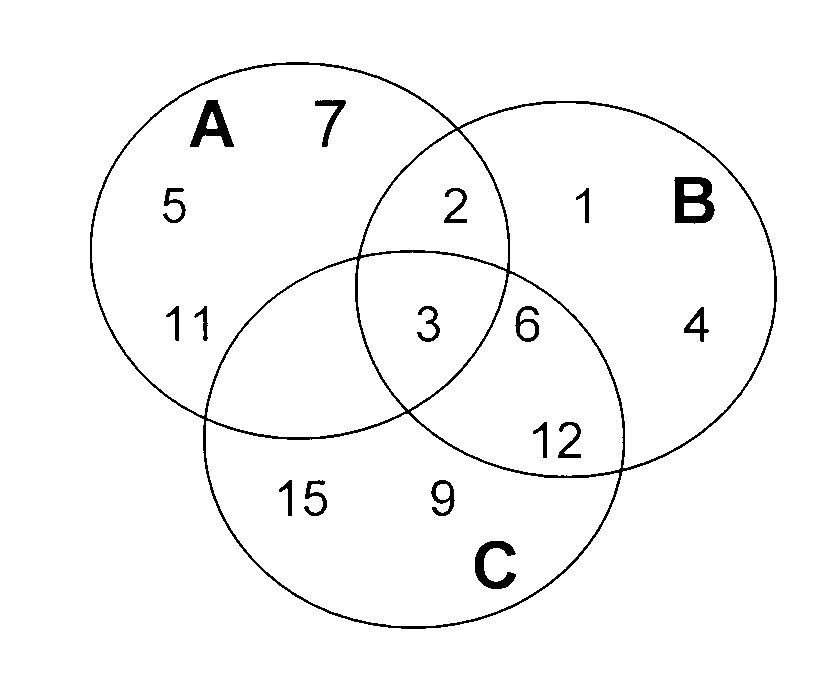
4.4 n(not A)
4.6 P(not (A or B))
4.6 P(not (A or B))
4.5 P(A)
4.7 P(A and B and C)
4.7 P(A and B and C)
5. Die volgende Venn diagram stel die sportkeuse
van 45 leerlinge voor. Die leerlinge kon kies tussen
sokker (S), tennis (T) en krieket (C))
Gebruik die diagram om die volgende te bepaal :
5.1 n(S)
5.2 n(C)
5.3 x
5.4 Indien 'n leerling ewekansig gekies word, bereken
die waarskynlikheid, in sy eenvoudigste vorm, dat
die leerling
5.4.1 net tennis speel.
5.4.2 sokker en tennis maar nie krieket speel nie.
5.4.3 al drie sportsoort beoefen.
5.4.4 nie sokker speel nie.
van 45 leerlinge voor. Die leerlinge kon kies tussen
sokker (S), tennis (T) en krieket (C))
Gebruik die diagram om die volgende te bepaal :
5.1 n(S)
5.2 n(C)
5.3 x
5.4 Indien 'n leerling ewekansig gekies word, bereken
die waarskynlikheid, in sy eenvoudigste vorm, dat
die leerling
5.4.1 net tennis speel.
5.4.2 sokker en tennis maar nie krieket speel nie.
5.4.3 al drie sportsoort beoefen.
5.4.4 nie sokker speel nie.
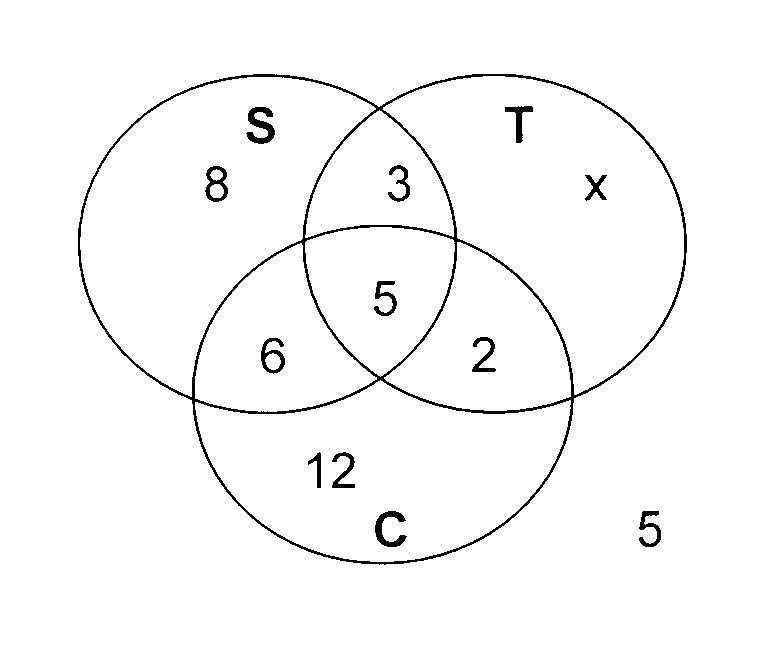
5. The following Venn diagram represents the chosen sport by 45 pupils. The pupils could choose between
soccer (S), tennis (T) and cricket (C).
Use the diagram to determine the following :
soccer (S), tennis (T) and cricket (C).
Use the diagram to determine the following :
5.1 n(S)
5.3 x
5.3 x
5.2 n(C)
5.4 If a pupil is selected at random, calculate the probability, in its simplest form, that the pupil will
5.4.1 play only tennis.
5.4.3 participate in all three activities.
5.4.3 participate in all three activities.
5.4.2 play soccer and tennis but not cricket.
5.4.4 not play soccer.
5.4.4 not play soccer.
6.1 Indien n(A) = 15 en n(A of B) = 25, bepaal n(B).
6.2 Indien n(A) = 11, n(C) = 18 en n(A of C) = 25,
bepaal n(A en C).
6.3 Indien n(A) = 22, n(A en C) = 10 en n(A of C) = 49,
bepaal n(C).
6.1 If n(A) = 15 and n(A or B) = 25, determine n(B).
6.2 If n(A) = 11, n(C) = 18 and n(A or C) = 25,
determine n(A and C).
6.3 If n(A) = 22, n(A en C) = 10 and n(A or C) = 49,
determine n(C).
.
6.2 Indien n(A) = 11, n(C) = 18 en n(A of C) = 25,
bepaal n(A en C).
6.3 Indien n(A) = 22, n(A en C) = 10 en n(A of C) = 49,
bepaal n(C).
6.1 If n(A) = 15 and n(A or B) = 25, determine n(B).
6.2 If n(A) = 11, n(C) = 18 and n(A or C) = 25,
determine n(A and C).
6.3 If n(A) = 22, n(A en C) = 10 and n(A or C) = 49,
determine n(C).
.
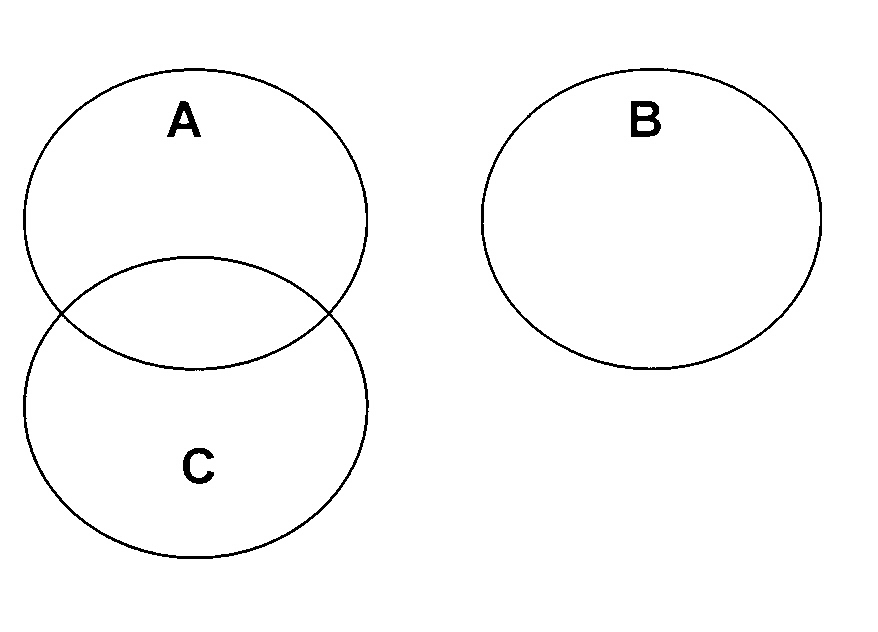
7. Die diagram toon die verspreiding van die 42
leerlinge in 'n Graad 10 klas. Daar is 20 seuns (A)
en 22 dogters (E) in die klas. Tien seuns en
14 dogters neem Wiskunde (X) en 10 seuns en
10 dogters neem Fisiese Wetenskap (Y).
7.1 Bereken q.
7.2 Gebruik die Venn diagram om die waarskynlikheid,
in sy eenvoudigste vorm, te bereken dat 'n
willekeurig gekose leerling
7.2.1 'n seun is.
7.2.2 'n dogter is wat Wiskunde neem.
7.2.3 'n seun is wat Fisiese Wetenskap neem.
7.2.4 Wiskunde en Fisiese Wetenskap neem.
7.2.5 'n seun is wat nie Wiskunde neem nie.
leerlinge in 'n Graad 10 klas. Daar is 20 seuns (A)
en 22 dogters (E) in die klas. Tien seuns en
14 dogters neem Wiskunde (X) en 10 seuns en
10 dogters neem Fisiese Wetenskap (Y).
7.1 Bereken q.
7.2 Gebruik die Venn diagram om die waarskynlikheid,
in sy eenvoudigste vorm, te bereken dat 'n
willekeurig gekose leerling
7.2.1 'n seun is.
7.2.2 'n dogter is wat Wiskunde neem.
7.2.3 'n seun is wat Fisiese Wetenskap neem.
7.2.4 Wiskunde en Fisiese Wetenskap neem.
7.2.5 'n seun is wat nie Wiskunde neem nie.
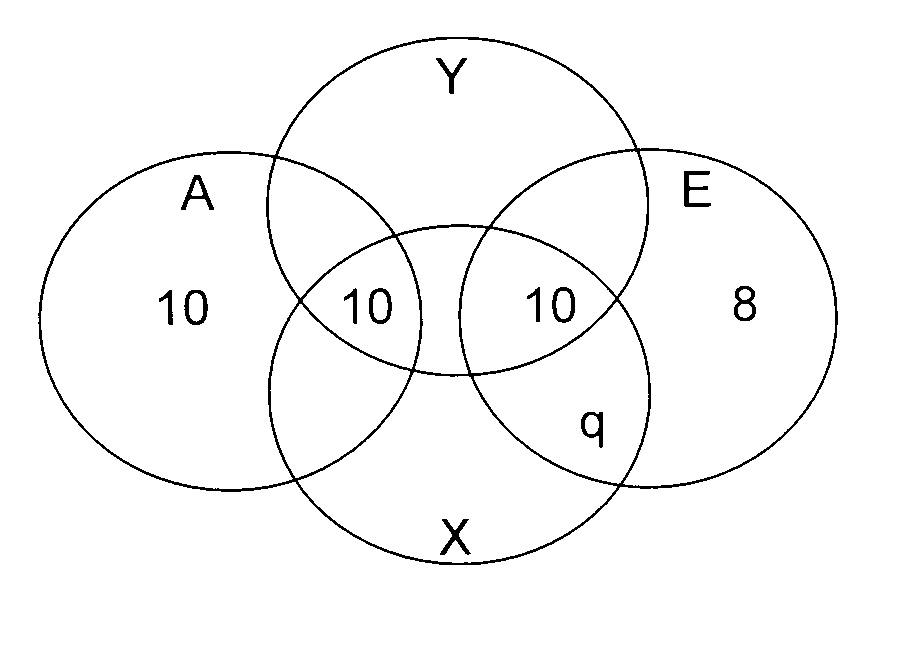
7.2.6 'n dogter is wat Wiskunde maar nie Fisiese Wetenskap neem nie.
7.3 'n Leerling word willekeurig gekies. Gebruik die Venn diagram om die volgende waarskynlikheid,
in sy eenvoudigste vorm, te bereken :
7.3 'n Leerling word willekeurig gekies. Gebruik die Venn diagram om die volgende waarskynlikheid,
in sy eenvoudigste vorm, te bereken :
7.3.1 P(E)
7.3.3 P(X of Y) of P(X ∪ Y)
7.3.5 P(nie X nie) of P(X')
7.3.7 P(A en nie X nie)
7.4 Is A en E onderling uitsluitend? Gee 'n rede.
7.3.3 P(X of Y) of P(X ∪ Y)
7.3.5 P(nie X nie) of P(X')
7.3.7 P(A en nie X nie)
7.4 Is A en E onderling uitsluitend? Gee 'n rede.
7.3.2 P(A en Y) of P(A ∩ Y)
7.3.4 P(X en Y)
7.3.6 P(net X)
7.3.4 P(X en Y)
7.3.6 P(net X)
7. The diagram shows the distribution of the 42 pupils
in a Grade 10 class. There are 20 boys (A)
and 22 girls (E) in the class. Ten boys and
14 girls take Mathemtaics (X) and 10 boys and
10 girls take Physical Science (Y).
7.1 Calculate q.
7.2 Use the Venn diagram to calculate the probability, in
its simplest form, that a pupil, selected at random,
7.2.1 is a boy.
7.2.2 is a girl taking Mathematics.
7.2.3 is a boy that takes Physical Science.
7.2.4 takes Mathematics and Physical Science.
7.2.5 is a boy that does not take Mathematics.
in a Grade 10 class. There are 20 boys (A)
and 22 girls (E) in the class. Ten boys and
14 girls take Mathemtaics (X) and 10 boys and
10 girls take Physical Science (Y).
7.1 Calculate q.
7.2 Use the Venn diagram to calculate the probability, in
its simplest form, that a pupil, selected at random,
7.2.1 is a boy.
7.2.2 is a girl taking Mathematics.
7.2.3 is a boy that takes Physical Science.
7.2.4 takes Mathematics and Physical Science.
7.2.5 is a boy that does not take Mathematics.

7.2.6 is a girl taking Mathemitics but not Physical
Science.
7.3 A pupil is chosen at random. Use the diagram to calculate the following probability, in its simplest form :
Science.
7.3 A pupil is chosen at random. Use the diagram to calculate the following probability, in its simplest form :
7.3.1 P(E)
7.3.3 P(X or Y) or P(X ∪ Y)
7.3.5 P(not X) or P(X')
7.3.7 P(A and not X)
7.4 Are A and E mutually exclusive? Give a reason.
7.3.3 P(X or Y) or P(X ∪ Y)
7.3.5 P(not X) or P(X')
7.3.7 P(A and not X)
7.4 Are A and E mutually exclusive? Give a reason.
7.3.2 P(A and Y) or P(A ∩ Y)
7.3.4 P(X and Y)
7.3.6 P(only X)
7.3.4 P(X and Y)
7.3.6 P(only X)
1
1
8.
A en B is twee gebeurtenisse met P(A) = ──
8.
A and B are two events such that P(A) = ──
4
4
11
11
en P(B) = ──
and P(B) = ──
24
24
As A en B onderling uitsluitend is, bepaal
If A and B are mutually exclusive, determine
8.1
P(A en B) of P(A ∩ B)
8.1
P(A and B) or P(A ∩ B)
8.2
P(A of B) of P(A ∪ B)
8.2
P(A or B) or P(A ∪ B)
2
2
9.
A en B is twee gebeurtenisse met P(A) = ──
9.
A and B are two events such that P(A) = ──
5
5
7
7
en P(B) = ── Bepaal P(A ∩ B) as
and P(B) = ── Determine P(A ∩ B) if
15
15
13
13
9.1
P(A ∪ B) = ──
9.1
P(A ∪ B) = ──
15
15
3
3
9.2
P(A ∪ B) = ──
9.2
P(A ∪ B) = ──
5
5
10.
Bepaal
10.
Determine
2
3
2
3
10.1
P(A ∩ B) as P(A) = ── ; P(B) = ──
10.1
P(A ∩ B) if P(A) = ── ; P(B) = ──
7
8
7
8
37
37
P(A ∪ B) = ───
P(A ∪ B) = ───
56
56
2
3
2
3
10.2
P(A ∪ B) as P(A) = ── ; P(B) = ──
10.2
P(A ∪ B) if P(A) = ── ; P(B) = ──
9
11
9
11
2
2
P(A ∩ B) = ───
P(A ∩ B) = ───
33
33
3
1
3
1
10.3
P(B) as P(A) = ── ; P(A ∪ B) = ──
10.2
P(B) if P(A) = ── ; P(A ∪ B) = ──
8
2
8
2
5
5
P(A ∩ B) = ───
P(A ∩ B) = ───
24
24
11. 'n Sak bevat 12 identiese balle, genommer
van 1 tot 12. A, B en C is die volgende
drie gebeurtenisse :
A is die eerste vyf priemgetalle.
B is die ewe getalle.
C is die faktore van 12.
11.1 Lys gebeurtenisse A, B en C.
11.2 'n Bal word nou ewekansig uit die sak
gehaal. Gebruik die lyste in 11.1 om die
volgende waarskynlikhede, in hulle
eenvoudigste vorm, te bereken :
11.2.1 P(A)
11.2.2 P(A ∩ B)
11.2.3 P(A ∪ B)
11.2.4 P(B ∪ C)
11.2.5 P(A ∩ C)
11.2.6 P(A ∩ B ∩ C)
11.3 'n Bal word weer ewekansig uit die sak
gehaal. Bereken die waarskynlikheid,
in sy eenvoudigste vorm, dat die
nommer op die bal :
11.3.1 'n 7 sal wees.
11.3.2 groter as 8 sal wees.
11.3.3 'n ewe getal groter as 7 sal wees.
11.3.4 'n faktor van 15 sal wees.
11.3.5 gelyk sal wees aan 13.
11.3.6 'n onewe faktor van 12 sal wees.
van 1 tot 12. A, B en C is die volgende
drie gebeurtenisse :
A is die eerste vyf priemgetalle.
B is die ewe getalle.
C is die faktore van 12.
11.1 Lys gebeurtenisse A, B en C.
11.2 'n Bal word nou ewekansig uit die sak
gehaal. Gebruik die lyste in 11.1 om die
volgende waarskynlikhede, in hulle
eenvoudigste vorm, te bereken :
11.2.1 P(A)
11.2.2 P(A ∩ B)
11.2.3 P(A ∪ B)
11.2.4 P(B ∪ C)
11.2.5 P(A ∩ C)
11.2.6 P(A ∩ B ∩ C)
11.3 'n Bal word weer ewekansig uit die sak
gehaal. Bereken die waarskynlikheid,
in sy eenvoudigste vorm, dat die
nommer op die bal :
11.3.1 'n 7 sal wees.
11.3.2 groter as 8 sal wees.
11.3.3 'n ewe getal groter as 7 sal wees.
11.3.4 'n faktor van 15 sal wees.
11.3.5 gelyk sal wees aan 13.
11.3.6 'n onewe faktor van 12 sal wees.
11. A bag contains 12 identical balls, numbered
1 to 12. A, B and C are the following
three events :
A is the first five prime numbers.
B is the even numbers.
C is the factors of 12.
11.1 List events A, B and C.
11.2 A ball is removed at random from the bag.
Use the lists in 11.1 to calculate in its
simplest form the following probabilities :
11.2.1 P(A)
11.2.2 P(A ∩ B)
11.2.3 P(A ∪ B)
11.2.4 P(B ∪ C)
11.2.5 P(A ∩ C)
11.2.6 P(A ∩ B ∩ C)
11.3 A ball is again removed at random from the
bag. Calcualte in its simplest form, the
probability that the number on the ball will be :
11.3.1 a 7.
11.3.2 greater than 8.
11.3.3 an even number greater than 7.
11.3.4 a factor of 15.
11.3.5 equal to 13.
11.3.6 an odd factor of 12.
1 to 12. A, B and C are the following
three events :
A is the first five prime numbers.
B is the even numbers.
C is the factors of 12.
11.1 List events A, B and C.
11.2 A ball is removed at random from the bag.
Use the lists in 11.1 to calculate in its
simplest form the following probabilities :
11.2.1 P(A)
11.2.2 P(A ∩ B)
11.2.3 P(A ∪ B)
11.2.4 P(B ∪ C)
11.2.5 P(A ∩ C)
11.2.6 P(A ∩ B ∩ C)
11.3 A ball is again removed at random from the
bag. Calcualte in its simplest form, the
probability that the number on the ball will be :
11.3.1 a 7.
11.3.2 greater than 8.
11.3.3 an even number greater than 7.
11.3.4 a factor of 15.
11.3.5 equal to 13.
11.3.6 an odd factor of 12.